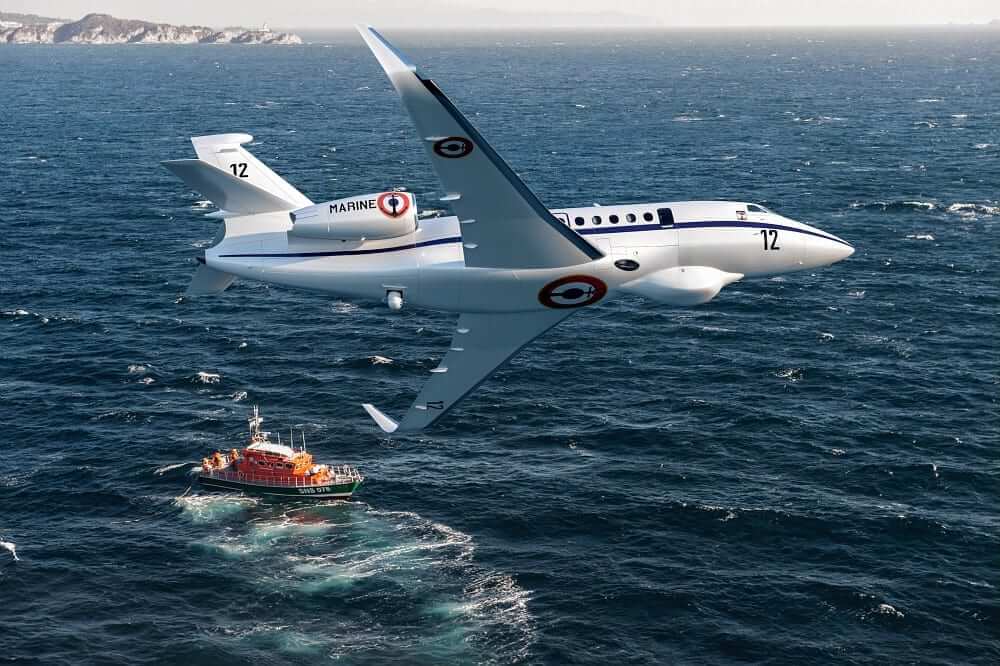There are numerous links between business and military aviation. And if some manufacturers like to highlight elements taken from their combat aircraft and integrated into their corporate jets, there is a reciprocal relationship. Indeed, some aircraft developed for exclusive travel find their way into the fleet of various air forces, and not only for the purpose of personnel transportation. But what makes business aircraft such good military platforms?
Manufacturers have an established track record of turning jet airliners into military aircraft. It started with the likes of the de Havilland Comet which morphed into the Hawker Siddeley Nimrod maritime patrol aircraft at the end of its civilian life. There was also the Boeing 707, with the Boeing E-3 Sentry airborne early warning and control aircraft still widely in use.
The airframe of a commercial jet allows the military long-range capability and a cabin large enough to fit necessary equipment. The poster child of these features is no less than the Boeing 747. The Queen of the Skies gave birth to a plethora of military variants, including the E-4B airborne command post colloquially known as the ‘Doomsday Plane’, and the iconic VC-25, used as Air Force One by the United States Air Force (USAF) to transport the US President. The 747’s 4,000 square feet of cabin space offers enough room to fit in numerous amenities, not least the presidential quarters (with a gym), a situation room, a medical room, and even an operating room.
However, the past decade has seen an increased interest from the military in another area of civilian aviation: business aviation.
Such are the similarities between some military and corporate jets, it is not always easy to tell them apart.
Early on January 27, 2020, news emerged that an aircraft had gone down in the eastern province of Ghazni, to the southwest of Kabul, Afghanistan’s capital. Initial reports were unclear as to what type of airplane was involved. Eventually, the local governor’s office said the aircraft was a “plane belonging to the Ariana Afghan Airline”. However, the national carrier’s CEO denied it, saying all planes were accounted for.
Once photos and footage of the crash site emerged online, the reason for the misunderstanding and confusion became clear: the aircraft involved was in fact a Northrop Grumman E-11A communication relay plane of the USAF.
Based on the Bombardier Global Express 6000, the E-11A is an airborne communication relay, transmitting critical information from one military unit to the other, thanks to a Battlefield Airborne Communication Node (BACN) system developed by Northrop Grumman. Except for the USAF roundel on each engine nacelle, it was hard to distinguish the highly specialized aircraft from a regular corporate jet.
With the ever-advancing miniaturization of electronics, the need for large cabins to fit the equipment needed for observation or communication missions has decreased. Similarly, advances in engine technology mean that the range of corporate jets has now reached a point where bigger aircraft with larger engines are superfluous.
Consequently, contracts for strategic aircraft based on business jet airframes have flourished in the past few years.
The Bombardier Global Express 6000 is one such success. In addition to the E-11A mentioned earlier, the jet was also converted by Raytheon into a battlefield surveillance plane for the Royal Air Force: the Sentinel R.Mk-1.
More recently, Saab turned Bombardier’s jet into an early warning and control (AEW&C) platform for the United Arab Emirates, giving birth to the GlobalEye. The first aircraft was delivered on April 29, 2020. In an attempt to tip the scales in its favor in the ongoing Finnish fighter procurement tender, Saab has offered Finland two GlobalEye aircraft in addition to its Gripen fighters.
But Bombardier-based aircraft are not alone in this niche market.
Since 1995, the Swedish Air Force has been using two S102B ‘Korpen’, a pair of Gulfstream IV business jets converted for signals intelligence (SIGINT) missions. The aircraft can be regularly seen patrolling above the Baltic Sea, off the Russian enclave of Kaliningrad.
In January 2020, the French procurement and technology agency (DGA) awarded the Archange airborne strategic intelligence program to Dassault Aviation and Thales. This program will see three Dassault Falcon 8X being fitted with Thales electronic intelligence technologies.
The Falcon 8X will replace the larger Transall C-160G Gabriel aircraft. Not only is the business jet smaller and lighter, it is also twice as fast at 609 miles per hour (980 kilometers per hour) against 319 miles per hour (513 kilometers per hour) for the C160. In addition, it offers a superior range of 7,425 miles (11,950 kilometers) compared to 5,504 miles (8,858 kilometers) for its predecessor.
This trend is expected to continue.
In July 2021, when the Maritime Airborne Warfare Systems (MAWS) program envisioned by France and Germany seemed about to collapse, Dassault enthusiastically suggested to the French government that it could convert its upcoming Falcon 10X into a maritime patrol aircraft.
Once again, the technological leap would be tremendous, as 56 years separate the Dassault-Breguet Br.1150 (Atlantique 2) currently in operation in the Marine Nationale, and the Falcon 10X, the latest addition to the Falcon business jet family and the largest business jet by the French manufacturer to date.
To fully replace the Atlantique 2, however, the Falcon 10X would have to carry an array of anti-submarine weapons, including torpedoes, grenades and missiles. The weaponization of a corporate jet would mark a new milestone in the versatility of those platforms.

